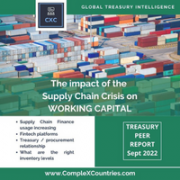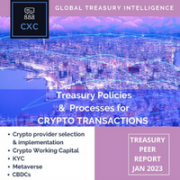Main blockchain and crypto trends in 2022: unexpected expectations
18-01-2022 | Carlo de Meijer | treasuryXL | LinkedIn |
For me it is becoming a sort of tradition. Writing a blog about the upcoming trends in the Blockchain and crypto arena for the next year and beyond.

A year ago I concluded with the sentence: “always expect the unexpected”.
And unexpected was the upcoming of the DeFi market, as well that of NFT. But also a growing number of traditional banks entering the crypto scene, increasingly believing crypto is here to stay. What may bring this year? This will be described in the following 15 trends.
1. New third and fourth generation blockchain solutions
A first trend we will observe is de-acceleration in the development of new third and fourth-generation solutions aimed at removing the speed and scalability challenges. Third-generation blockchain platforms like Aion, Cardano, and EOS, introduced technology such as sharding to tackle scaling issues in order to cut down on cost and speed of transactions. These platforms also matured the distributed application capabilities of blockchain.
And there are fourth-generation blockchains aimed to resolve prior challenges and enable trust in easy-to-consume ways, accelerating the formation, operation, and reconfiguration of business networks. In addition to greater ease of onboarding, these lower cost, and highly scalable platforms are built to make pragmatic trade-offs such as recognizing that not all transactions are created equal using variable consensus mechanisms. Interesting fourth-generation blockchain platforms like Insolar and Aergo, are enabling business networks to be easier to use through business-oriented interfaces that hide the complexity of the underlying blockchain technology.
2. Towards more blockchain standardisation and interoperability
Another trend we will see in 2022 is an acceleration in the creation of standards and interoperability possibilities. These should enable multiple blockchains to communicate. The number of blockchain and distributed ledger networks are firmly growing. Most blockchain networks operate on isolated ecosystems as they try to resolve a unique set of needs. Interconnecting these new chains is becoming a necessity as more people continue to take note of the emerging technology and its capabilities.
Standards are an important key to success for any developing technology, and blockchain is no exception. The right standards, set at the right time in a technology’s development, can ensure interoperability, generate trust in and help ensure ease of use of the technology. In this way, they support its development and create a pathway to mass adoption.
The rapid development of blockchain is set to give rise to many different kinds of chains. One such technology that is becoming increasingly evident is cross-chain technology, an emerging technology that seeks to allow the transmission of value and information between different blockchain networks. This technology is increasingly becoming a hot topic of discussion seen as the ultimate solution for enhancing interoperability between blockchains.
3. Blockchain-as-a-service (BaaS) solutions
BaaS has emerged as a boosting adoption across business companies due to many developments in this atmosphere of blockchain. The demand for Blockchain-as-a-service (BaaS), a third-party creation and management of cloud-based networks for companies in the business of creating blockchain applications, among companies is firmly growing and that will continue in 2022. Main players in this space include Microsoft, Amazon and R3.
BaaS facilitates its clients to leverage the solutions to build hosts, based on the cloud and enable them to operate related functions on the blockchain and their applications, without having to overcome technical difficulties or operational overhead and without the need to invest in more infrastructure developments as well as lack of skills. BaaS operators help the clients to focus only on their core job and blockchain functions
4. Great demand for blockchain and crypto skills
The year 2022 will see a greater demand for blockchain and crypto skills. The potential for growth in the blockchain industry and the increasing dominance of blockchain across various sectors serve as a prominent reason for the increased demand for these skills. The promises of blockchain technology for enterprises in terms of cost efficiency and performance improvement and the booming development of the crypto markets translate directly into the rise in demand for blockchain professionals.
A report by LinkedIn has placed blockchain as one of the most in-demand skills for 2021 and beyond. Enterprises therefore need blockchain professionals with the skills to help them leverage most of blockchain technology for driving their business objectives.
5. Blockchain-IOT-G5 integration
This year we experienced a growing trend of blockchain being integrated with other technologies such as Big Data and Artificial Intelligence amongst others. There is also growing attention of corporates to use blockchain for IoT or Internet of Things applications.
The IoT market is increasing drastically and this is expected to continue in 2022 in an accelerated way triggered by the recent uptake of the 5G network. The expected potential of the 5G IoT market today is however limited by an extremely fragmented IoT ecosystem.
Blockchain technology appears as potentially the most suitable and efficient way to the various 5G IoT challenges. It can potentially help to solve many problems around security as well as scalability due to the automated encrypted and immutable nature of blockchain. It is expected to hear about more pilot projects and initial use cases in this field during 2022.
6. Blockchain and the Metaverse
Blockchain applications in Metaverse are another top blockchain trend in 2002. Metaverse is the emerging universe of the formerly known Facebook where there will be ‘immersive’ experiences with new technologies like blockchain, augmented reality, virtual reality etc. Without blockchain technology the Metaverse would be incomplete because everything would be stored in the centralised network.
Blockchain will enable the upcoming of a new wave of social networks that could be bigger and even better than the existing ones such as the former Facebook, Instagram, Twitter, and YouTube that are now synonymous with the word social media.
Blockchain in 2022 is expected to run multiple platforms on Metaverse with NFTs and cryptocurrencies. Digital assets like NFTs will thereby define ownership on the Metaverse and cryptocurrencies will power the new digital economy. Moreover, also Twitter, with its vast user base of 192 million daily active users, is now planning to integrate cryptocurrencies into the platform with things like Bitcoin tipping for creators.
7. Blockchain and governments
Governments are also starting to enter the blockchain market. Blockchain provides new ways for governments to organize processes and handle information in a more efficient way. Over the past few years, governments in several countries have been experimenting with the application of this novel technology to a wide variety of functions and services, including land registration, educational credentialing, health care, procurement, food supply chains, and identity management.
What is holding back various governments up till now is the factor of trust. The World Bank therefore proposes a “Three Layer” design and implementation framework, to prevent potential glitches between the technology and its intended application. Their framework comprises the social layer, data layer, and technical layer. The social layer constitutes human actors and social aspects such as incentives and motivation among others.
The data layer is the ledger itself and what it provides in terms of usability, security, authenticity, and reliability. The technical layer comprises DLT protocols, data storage, and consensus mechanisms among others.
8. More projects on CBDCs
With 80% of the world’s central banks now exploring Central Bank Digital Currency (CBDC) projects during 2021, according to the Bank of International Settlement, the year 2022 will see a further breakthrough. Governments worldwide realise that cryptocurrencies are here to stay and the majority of CBDCs are being introduced to ensure their monetary system stays relevant to consumer demands and not necessarily to eradicate the use of Bitcoin and other private cryptocurrencies.
Despite most central banks are still planning their frameworks for what a CBDC might look like, there are already CBDCs that have gone live. These however are limited to a few small countries including the Bahamas, Cambodia, the Eastern Caribbean States and most recently followed by Nigeria.
In terms of developed nations, China and Sweden (e-krona) are the most advanced with extensive pilots having already taken place. China is expecting to further test its CBDC – digital yuan – during the Winter Olympics in early 2022. This will certainly trigger other central banks including those of the UK, the US, Russia, Japan and the European Central Bank, to follow suit.
9. The DeFi market will further boom ….
DeFi, or decentralised finance is quickly emerging as a transparent and permissionless way for users to interact directly with each other. This year the value of assets in DeFi reached more than $180 bn and expectations are that this will further rise in 2022. As there is an increasing need to replicate physical items properties like uniqueness, ownership proof, we will see further uptake of the DeFi market as well as the arrival of more dedicated DeFi applications. Upcoming regulation, as well as the growing acceptance that crypto is here to stay, may in the longer term lead to more convergence between traditional or centralised finance (CeFi) and decentralised finance (DeFi).
10. ….. as well as NFTs
The remarkable growth of the NFT market in 2021 is expected to continue in 2022. As almost everything is becoming digital, there is an increasing need to replicate physical items properties like more uniqueness, ownership proof and scarcity. The Metaverse concept that was earlier described will bring plenty of new opportunities for innovative NFT use cases.
Various new use cases including gaming, music, ticketing, post on social media etc. are entering the NFT market attracted by the various benefits and the profits that can be made.
But the risks and challenges this market is confronted with will ask for regulatory intervention. This raises the importance of having an international regulatory body of non-fungible tokens for its better regulation and legalization. The outcome could have a great impact and will be decisive for the future of NTFs. It is however still uncertain how that will proceed.
11. Large banks are entering the DeFi market
The attitude of traditional banks, especially the larger ones towards crypto and DeFi is changing. . With central banks around the world beginning to embrace the concept of CDBCs and stablecoins, the principles underlying the DeFi industry will gain more and more acceptance amongst traditional firms. The banking industry is beginning to see DeFi’s potential to overhaul the inflexibility of present processes and are reacting. More and more established banks, pushed by the demands of their clients and shareholders, are now exploring how they might engage with DeFi and the crypto markets. While this year some big names entered the DeFi space in order to meet their customers’ demand for crypto thereby delivering a number of DeFi based applications, this number will further increase in 2022 thereby seeking greater exposure to the DeFi space.
12. We will see more DAOs
To meet the upcoming governance issues at DeFi organisations we will see the arrival of more decentralised autonomous organisations or DAOs in 2022 and beyond.
The decision-making, or governance, at DeFi organizations (from the fees they charge users to the products they offer) is often meant to be decentralized. In the initial stage of DeFi a single person or a small group of people might be driving a decentralized application at inception. But as the DeFi project gains momentum they often seek to step away, thereby handing over control to the community that uses it.
That transition is expected to be increasingly in the form of a decentralized autonomous organization (DAO). They have their rules and regulations embedded in programming code via smart contracts and may issue governance tokens, which give holders of those coins a say in decisions.
13. The number of challenger banks and crypto banks will further grow
A new trend we will see in the years to come is the rising number of challenger and crypto banks, aimed at meeting the needs of millennials and the Gen Z generation. Both are increasingly looking to new ways money is being managed. This has led to the emergence of challenger banks that are making finance fully digital. But even this is not enough for the 25-year-olds and under, Gen Z. Saving, making money work, and being in control of finances is a key difference between millennials and Gen Z and this is where cryptocurrency starts to enter the discussion. This will intensify the upcoming of crypto banks.
14. Crypto currency rates to more realistic levels
Notwithstanding there is a growing demand for cryptocurrencies not only from consumers but also from institutional investors as well as large financial institutions, 2022 will see the end of the cryptocurrency hype, a further correction in crypto rates and the return to more realistic levels, triggered by the upcoming regulations worldwide (see trend 15).
Notwithstanding the growing importance of the DeFi and NFT markets, the year 2022 may see crypto currencies lose some of their magic. Investors are greatly overestimating the speed with which the related blockchain technology will see a broad-based adoption. This may retrace trading euphoria in a bigger way in the cryptocurrency space.
15. Regulators are making up their mind
And finally, but most important, a growing number of regulators around the world – long-time struggling how to deal with the various crypto issues – will intensify their work and come up with regulatory measures, both individually and collectively. Aim is to meet the various risks and challenges of the crypto industry, including cryptocurrencies, crypto assets, stable coins, DeFi, NFT etc. on one hand, but without frustrating or harming technology developments.
While some countries have banned cryptocurrency entirely, there is a growing trend that regulators believe cryptocurrencies are here to stay and try to partially control their flow in the economy. International institutions like BIS, IMF, World Bank and others however are messaging that international regulatory collaboration and a cohesive regulatory framework is urgently needed.
Promising 2022
Dear followers. All these trends are based on a number of premisses. Thereby older trends play an important role in making these forecasts. If all these predictions come through, 2022 will be a great year for blockchain and the crypto industry. But as I also concluded in my blog on the trends of 2021: always expect the unexpected. Curious to experience.
Carlo de Meijer
Economist and researcher












